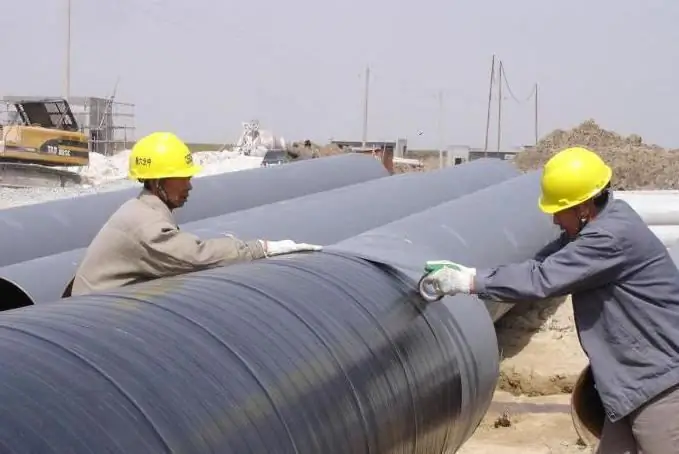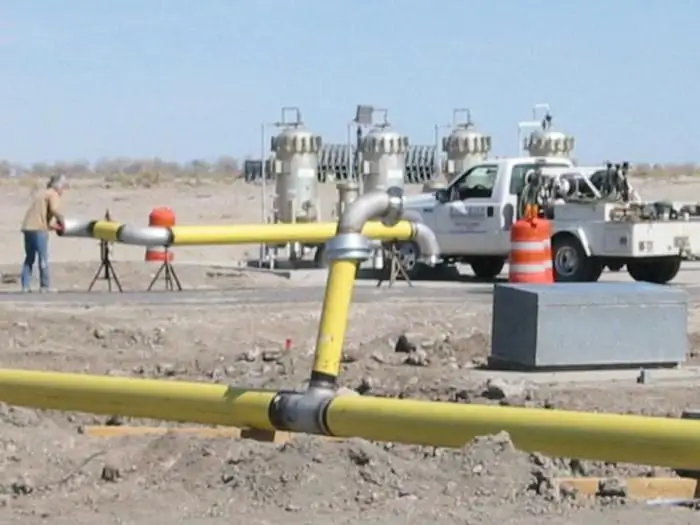2026 Author: Howard Calhoun | [email protected]. Last modified: 2025-01-24 13:10:41
Means of protection against corrosion allow to extend the service life of a metal structure, as well as to preserve its technical and physical properties during operation. Despite the variety of methods for providing anti-corrosion action, it is possible to completely protect objects from rust damage only in rare cases.
The effectiveness of such protection depends not only on the quality of the tread technology, but also on the conditions of its application. In particular, to preserve the metal structure of pipelines, electrochemical corrosion protection based on the operation of cathodes demonstrates its best properties. Prevention of rust formation on such communications, of course, is not the only scope of this technology, but in terms of the combination of characteristics, this direction can be considered as the most relevant for electrochemical protection.
General information about electrochemical protection

Protection of metals from rust through electrochemical action is based on the dependence of the electrode potential of the material on the rate of the corrosion process. Metal structures must be used in thatpotential range where their anodic dissolution will be below the acceptable limit. The latter, by the way, is determined by the technical documentation for the operation of the facility.
In practice, electrochemical corrosion protection involves connecting a source with direct current to the finished product. The electric field on the surface and in the structure of the protected object forms the polarization of the electrodes, which also controls the process of corrosion damage. In essence, the anode zones on the metal structure become cathodic, which allows negative processes to be displaced, ensuring the structure of the target object is preserved.
The principle of operation of cathodic protection
There is cathodic and anode protection of the electrochemical type. Nevertheless, the first concept, which is used to protect pipelines, has received the greatest popularity. According to the general principle, when implementing this method, a current with a negative pole is supplied to the object from an external source. In particular, a steel or copper pipe can be protected in this way, as a result of which the polarization of the cathode sections will occur with the transition of their potentials to the anode state. As a result, the corrosive activity of the protected structure will be reduced to almost zero.

At the same time, cathodic protection can have different versions. The above-described technique of polarization from an external source is widely practiced, but the electrolyte deaeration method with a decrease in the rate of cathodic processes, as well as the creation of a protective barrier, also works effectively.
It has already been noted more than once that the principle of cathodic protection is implemented by an external current source. Actually, the main function of anti-corrosion protection lies in its work. These tasks are performed by special stations, which, as a rule, are part of the general pipeline maintenance infrastructure.
Cathodic Corrosion Protection Stations
The main function of the cathode station is to provide stable current to the target metal object according to the cathode polarization method. Such equipment is used in the infrastructure of underground gas and oil pipelines, in water supply pipes, heating networks, etc.
There are many varieties of such sources, while the most common cathodic protection device provides for the presence of:
- current converter equipment;
- wires for connecting to the protected object;
- anode ground electrode.
At the same time, there is a division of stations into inverter and transformer ones. There are other classifications, but they are focused on the segmentation of installations either by application or by technical characteristics and input data parameters. The basic principles of operation are most clearly illustrated by the indicated two types of cathode stations.

Transformer installations for cathodic protection
It should be noted right away that this type of station is obsolete. It is being replaced by inverter analogues, which have both pluses and minuses. Anyway,transformer models are used even at new electrochemical protection points.
The basis of such objects is a 50 Hz low-frequency transformer and a thyristor converter. For the thyristor control system, the simplest devices are used, including phase-pulse power controllers. A more responsible approach to solving control problems involves the use of controllers with broad functionality.
Modern cathodic corrosion protection of pipelines with such equipment allows you to adjust the parameters of the output current, voltage indicators, as well as equalize protective potentials. As for the disadvantages of transformer equipment, they come down to a high degree of current ripple at the output at a low power factor. This flaw is not explained by the sinusoidal form of the current.
To solve the problem with ripple, to a certain extent, it is possible to introduce a low-frequency choke into the system, but its dimensions correspond to the dimensions of the transformer itself, which does not always make such an addition possible.
Cathodic protection inverter station

Inverter-type installations are based on pulsed high-frequency converters. One of the main advantages of using stations of this type is high efficiency, reaching 95%. For comparison, for transformer installations, this figure reaches an average of 80%.
Sometimes other virtues come to the fore. For example, the small dimensions of inverter stations expandopportunities for their use in difficult areas. There are also financial advantages, which are confirmed by the practice of using such equipment. Thus, inverter cathodic corrosion protection of pipelines quickly pays off and requires minimal investment in technical maintenance. However, these qualities are clearly visible only when compared with transformer installations, but today there are more effective new means of providing current for pipelines.
Designs of cathode stations

Such equipment is available on the market in different cases, shapes and dimensions. Of course, the practice of individual design of such systems is also widespread, which makes it possible not only to obtain an optimal design for specific needs, but also to provide the necessary operational parameters.
Strict calculation of the characteristics of the station allows you to further optimize the cost of its installation, transportation and storage. For example, cathodic protection against corrosion of pipelines based on an inverter with a mass of 10-15 kg and a power of 1.2 kW is quite suitable for small objects. Equipment with such characteristics can be serviced by a car, however, for large-scale projects, more massive and heavy stations may be used, requiring the connection of trucks, a crane and installation teams.
Protective functionality

Special attention in the development of cathode stations is given to the protection of the equipment itself. To do this, we integratesystems that allow protecting stations from short circuits and load breaks. In the first case, special fuses are used to handle emergency operation of the units.
As for power surges and breaks, a cathodic protection station is unlikely to be seriously affected by them, but there may be a danger of electric shock. For example, if in normal mode the equipment is operated with a small voltage, then after a break, the jump in indicators can bring up to 120 V.
Other types of electrochemical protection
In addition to cathodic protection, electric drainage technologies are also practiced, as well as tread methods for preventing corrosion. The most promising direction is considered to be a special protection against the formation of corrosion. In this case, active elements are also connected to the target object, which ensure the transformation of the surface with cathodes by means of current. For example, a steel pipe as part of a gas pipeline can be protected by zinc or aluminum cylinders.
Conclusion

Methods of electrochemical protection cannot be classified as new and, moreover, innovative. The effectiveness of the use of such techniques in the fight against rusting processes has been mastered for a long time. However, one serious drawback prevents the wide distribution of this method. The fact is that cathodic corrosion protection of pipelines inevitably produces the so-called stray currents. They are not dangerous for the target structure, but may have a negative effect onnearby objects. In particular, stray current contributes to the development of the same corrosion on the metal surface of adjacent pipes.
Recommended:
Tread protection against corrosion. The main ways to protect pipelines from corrosion

Protective corrosion protection is a universal solution when it is required to increase the resistance of metal surfaces to moisture and other external factors
Corrosion inhibitors. Corrosion protection methods

Each year, about a quarter of all the metal produced in the world is lost due to the development and occurrence of corrosion processes. The costs associated with the repair and replacement of equipment and communications of chemical industries are often many times higher than the cost of materials required for their manufacture
Tanks whose protection is active. Active tank armor: principle of operation. Invention of active armor

How did active tank armor come about? It was developed and implemented by Soviet weapon manufacturers. The concept of active protection of iron machines was first voiced in one of the Tula design bureaus, around 1950. The first complex of the innovative invention "Drozd" was installed on the T-55AD tank, which the army received in 1983
Categories of pipelines. Determining the pipeline category. Classification of pipelines by categories and groups

Modern industry cannot do without quality pipelines. There are many types of them. What are the categories of pipelines, how to determine them, is described in the article
Instruction on labor protection for an engineer on labor protection, equipment operation

Almost every large enterprise has a labor protection specialist. The essence of his work is to maintain safety standards in the organization. No less important is the presence of a special document called "Labor Protection". All these things will be discussed further

